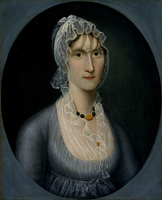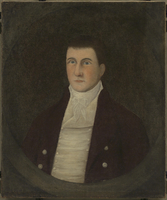Items
Tag
Joshua Johnson
-
 Portrait of Mrs. Barbara Baker Murphy (Wife of Sea Captain) Joshua Johnson, a self-trained artist and former slave, is the earliest documented professional African American painter. His sitters were Captain John Murphy and his wife, Irish immigrants who lived in Baltimore, where Johnson painted many merchants, seamen, and their families. In these portraits--intended to hang side-by-side--the artist delighted in fine details, from the captain's artfully arranged curls to his wife's sheer lace collar.
Portrait of Mrs. Barbara Baker Murphy (Wife of Sea Captain) Joshua Johnson, a self-trained artist and former slave, is the earliest documented professional African American painter. His sitters were Captain John Murphy and his wife, Irish immigrants who lived in Baltimore, where Johnson painted many merchants, seamen, and their families. In these portraits--intended to hang side-by-side--the artist delighted in fine details, from the captain's artfully arranged curls to his wife's sheer lace collar. -
 Portrait of John Westwood An oil painting portrait of John Westwood, painted in conventional English portrait style of formal, bust-length pose and arranged backdrop. It depicts a half-length male figure wearing a brown coat with silver buttons and white waistcoat against a dark background. The figure is clean shaven with short brown hair, and is encircled by a faux oval frame. Painted as part of the composition, the oval frame is slightly lighter in color than the background. (Smithsonian Collections Search Center)
Portrait of John Westwood An oil painting portrait of John Westwood, painted in conventional English portrait style of formal, bust-length pose and arranged backdrop. It depicts a half-length male figure wearing a brown coat with silver buttons and white waistcoat against a dark background. The figure is clean shaven with short brown hair, and is encircled by a faux oval frame. Painted as part of the composition, the oval frame is slightly lighter in color than the background. (Smithsonian Collections Search Center) -
 Portrait of Adelia Ellender Adelia Ellender lived in Baltimore, Maryland, where her father was a plasterer. Her dress follows the custom in this period of portraying children as miniature adults. The berries in her hand and the butterfly hovering in a rosebush nearby symbolize not only her childhood innocence but her eventual transformation into a lady
Portrait of Adelia Ellender Adelia Ellender lived in Baltimore, Maryland, where her father was a plasterer. Her dress follows the custom in this period of portraying children as miniature adults. The berries in her hand and the butterfly hovering in a rosebush nearby symbolize not only her childhood innocence but her eventual transformation into a lady -
 Joshua Johnson Joshua Johnson, or Johnston, the earliest documented professional African-American painter, was active in Baltimore during the late eighteenth and first quarter of the nineteenth century. His background, however, remains a mystery. The families and descendants of those whose portraits he painted claim that Johnson was a former slave. Whether Johnson was a slave or not is open to question since his name appears in the City Directory of Baltimore from 1796 to 1824, when the directory did not list slaves. Johnson's identity as an African American has been questioned as well. In editions of the directory in which an asterisk designated a person of color, there is no asterisk by Johnson's name. Johnson may have been biracial and fair enough to elude identification as an African American by publishers of the directory. In the directory of 1817, however, Johnson's name appears among the "free householders of Color" listed separately in the publication. (Smithsonian American Art Museum)
Joshua Johnson Joshua Johnson, or Johnston, the earliest documented professional African-American painter, was active in Baltimore during the late eighteenth and first quarter of the nineteenth century. His background, however, remains a mystery. The families and descendants of those whose portraits he painted claim that Johnson was a former slave. Whether Johnson was a slave or not is open to question since his name appears in the City Directory of Baltimore from 1796 to 1824, when the directory did not list slaves. Johnson's identity as an African American has been questioned as well. In editions of the directory in which an asterisk designated a person of color, there is no asterisk by Johnson's name. Johnson may have been biracial and fair enough to elude identification as an African American by publishers of the directory. In the directory of 1817, however, Johnson's name appears among the "free householders of Color" listed separately in the publication. (Smithsonian American Art Museum)